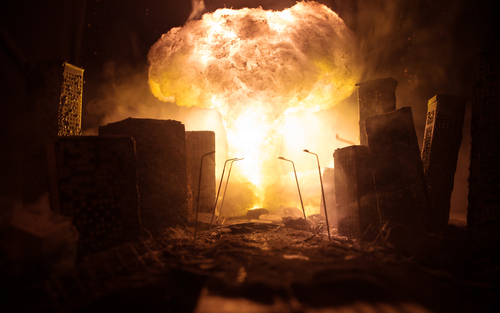
As global tensions rise, the specter of nuclear conflict looms larger than ever.
In these uncertain times, it is crucial to be prepared for all eventualities. Dr. Abud Bakri, a residency physician in California, compiled an extensive guide on surviving a nuclear fallout, drawing from extensive research and government documents.
The destructive power of a nuclear bomb is immense. Upon detonation, a shockwave extends about half a mile from the target, causing widespread devastation. Thermal damage can reach up to a mile, with flying debris traveling even further.
How to survive a nuke
Full version will be uploaded to YT channel – ApocalypseConsultant pic.twitter.com/ycmA68cXTk— ApocalypseConsultant (@OntarioTactical) October 14, 2023
The radiation from the blast could affect people within three-fourths of a mile from the explosion site. According to the US Department of Health and Human Services, lethal radiation could extend up to six miles, depending on wind direction.
Dr. Bakri identifies certain hotspots in the US that are likely to be primary targets in the event of a nuclear attack. These include intercontinental ballistic missile silos located in Colorado, Wyoming, Nebraska, Montana, and North Dakota.
These states were strategically chosen during the Cold War era due to their sparse population, earning them the moniker ‘Nuclear Sponge’ states.
A map released by the Natural Resources Defense Council in 2002 indicates potential nuclear targets across the country. Dense clusters are evident along the eastern seaboard and California, with large concentrations in Colorado, Montana, North Dakota, and Wyoming.
The map suggests parts of Idaho, Maine, northern California, and Oregon, due to their sparse populations and lack of nuclear plants, may be safer locations.
How to survive a nuke 101? Room 101… the place in 1984 where a prisoners worst nightmares came true? Fears of the end of the world? British blunders with genetically modified organisms? Sleepy Joe doxxing his own spec ops teams? Reminiscent of Seal Team 6 post Bin Laden raid? pic.twitter.com/ZBHItNJZxx
— Dopple Ganger mk2 (@DoppleGangerMk2) October 21, 2023
In the immediate aftermath of a nuclear blast, a series of events unfold. An intense flash of light appears, followed by the release of initial radiation.
The surrounding ground becomes a source of residual radiation, and an electromagnetic pulse could cause widespread technological disruption. Fires spark miles away, and blast waves reach at least one mile from the detonation site. A fallout cloud emerges, dropping hazardous particles back to Earth.
Dr. Bakri emphasizes three key survival concepts: distance from a nuclear blast, time exposed to radiation, and proper shielding. Being indoors, underground, wearing more clothes, and seeking shelter in structures made of lead can significantly increase chances of survival.
Immediately after the blast, it is advisable to remove contaminated clothes, shower or wash vigorously, and avoid eating and inhaling radioactive material.
The physician also suggests using a piece of lead to shield the pelvis if available. He explains that ordinary clothing can protect against alpha and beta radiation, but lead shelters are ideal for protection against gamma radiation, especially in the first 24 hours following a blast.
While the prospect of a nuclear war is terrifying, being prepared can make a significant difference. Understanding the potential effects of a nuclear blast and knowing how to protect oneself can increase the chances of survival.
As Dr. Bakri succinctly puts it, when it comes to surviving a nuclear apocalypse, it’s all about “location, location, location.”













